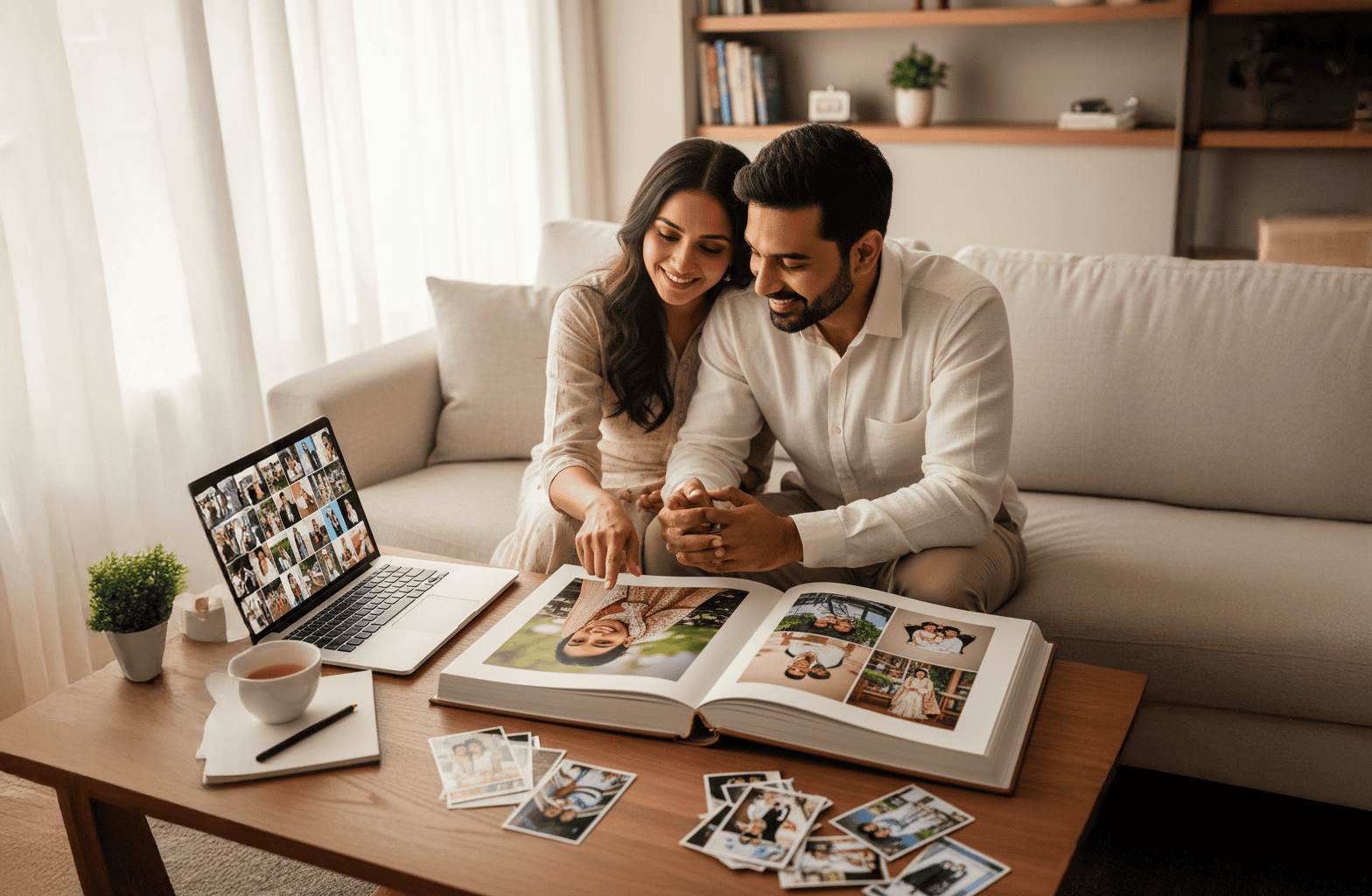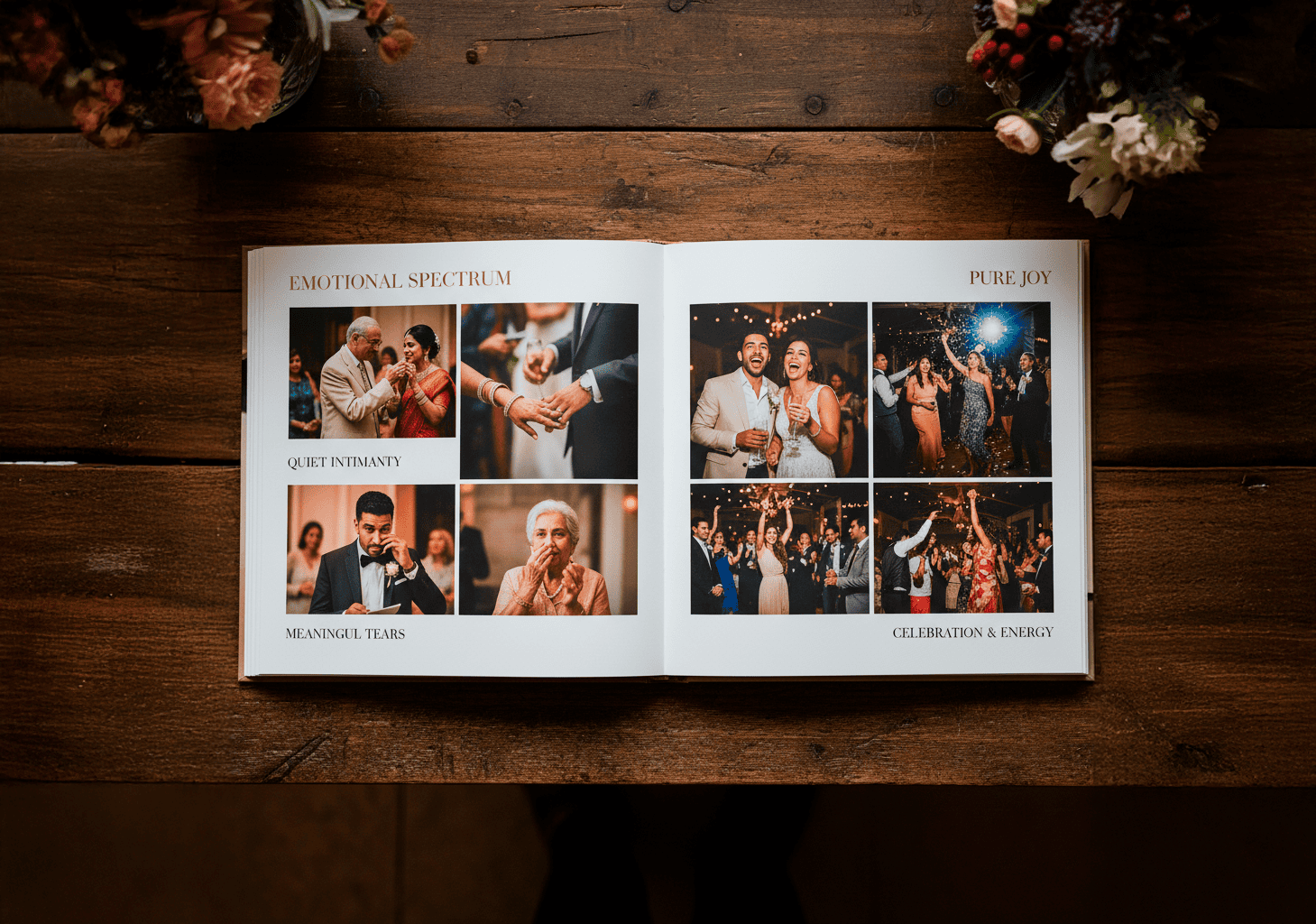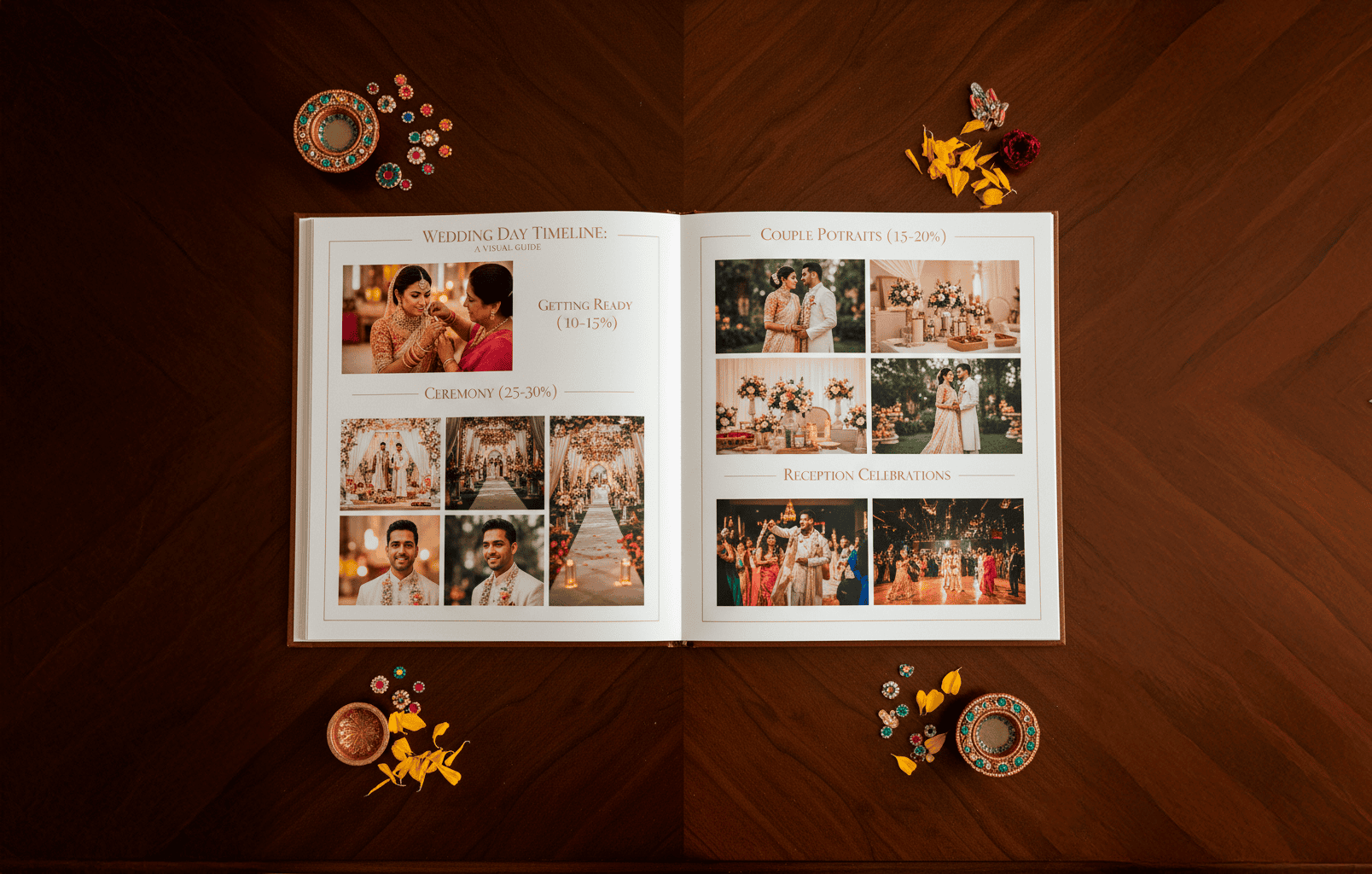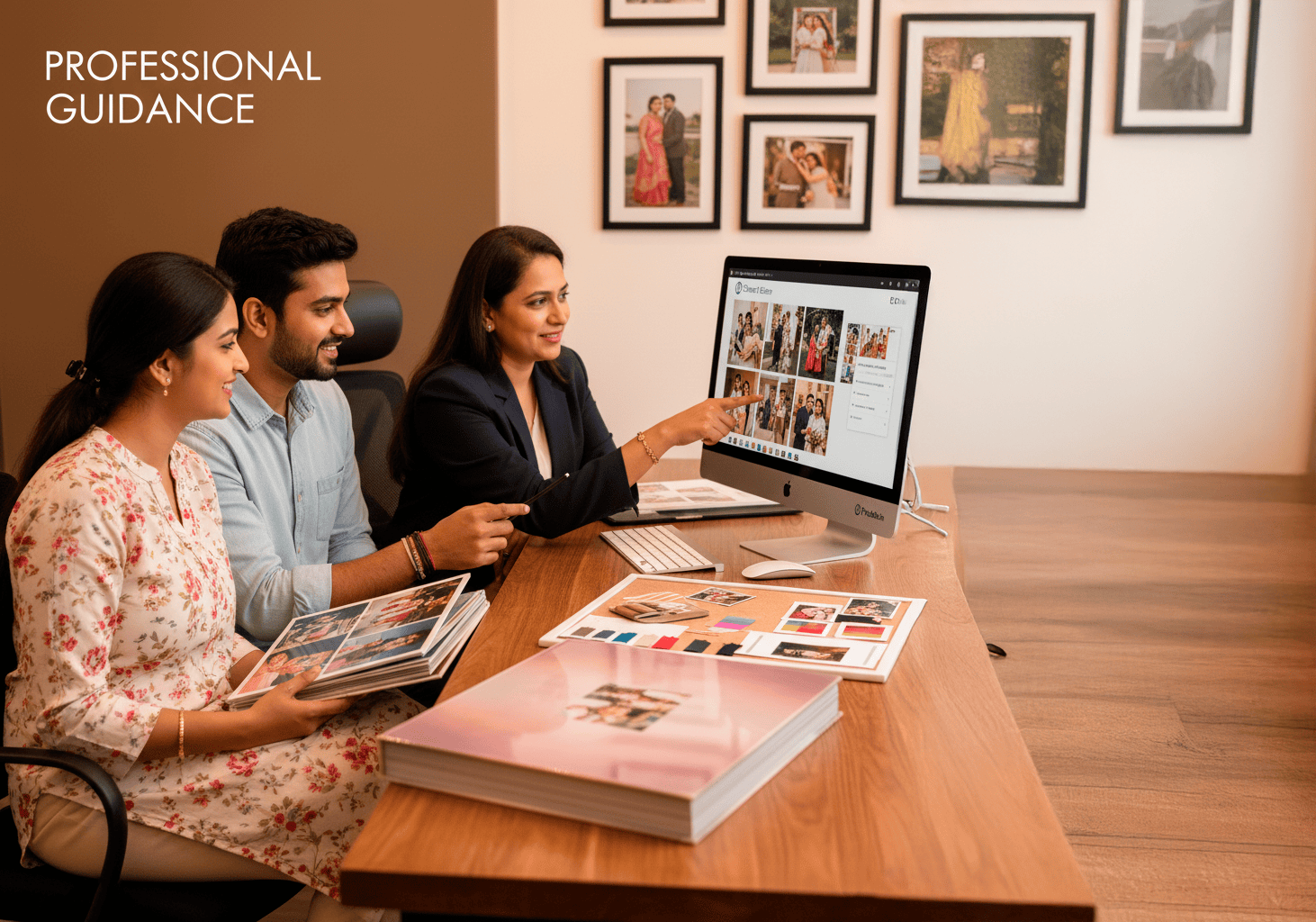How to Choose the Perfect Photos for Your Wedding Album: Expert Guide
Tips for Choosing the Right Photos for Your Wedding Album

Your wedding day flies by in a beautiful blur of emotions, laughter, and unforgettable moments. But long after the last dance and final toast, your wedding photo album becomes the tangible keeper of those precious memories. Choosing the right photos isn't just about picking pretty pictures—it's about crafting a visual story that captures the essence of your celebration and the love you share.
With hundreds (or even thousands) of images from your photographer, the selection process can feel overwhelming. Should you include every group photo? How many ceremony shots are too many? Which candid moments deserve a place in your album?
This comprehensive guide will walk you through proven strategies for curating a wedding album that's emotionally resonant, visually cohesive, and timelessly beautiful. Whether you're creating a traditional photo book or a modern lay-flat album, these tips will help you make confident decisions about which photos make the final cut.
Start with Your Story Arc
Every great wedding album tells a story with a beginning, middle, and end. Before diving into individual photos, think about the narrative structure of your day.
The Three-Act Structure
Act 1: Preparation & Anticipation
Begin with the quiet, intimate moments of getting ready. Include shots of the dress hanging in soft light, close-ups of jewelry or shoes, and candid moments with your wedding party. These photos set the emotional tone and build anticipation.
Act 2: The Ceremony & Celebration
This is the heart of your album. Capture the emotional peak moments—walking down the aisle, exchanging vows, the first kiss, and key ceremony rituals. Follow with cocktail hour highlights and reception celebrations.
Act 3: Joy & Connection
Close with photos that showcase the joy and connection of your celebration: first dances, heartfelt toasts, dance floor energy, and those final farewell moments. End on an emotional high note—perhaps a romantic couple's portrait at sunset or a joyful exit.
When you organize your selections around this story arc, your album naturally flows, creating an engaging experience that draws viewers through the entire day.
Consider Your Album Format
Different album styles support different storytelling approaches. A signature leather cover photo book with 40-60 pages requires more selective curation than a comprehensive coffee table book with 100+ images. Understanding your format helps guide your selection process.
Capture the Full Emotional Spectrum
The most powerful wedding albums don't just show what happened—they convey how it felt. Your photo selection should reflect the complete emotional journey of your wedding day.

Essential Emotional Moments
Quiet Intimacy: Look for photos that capture private, tender moments—a father adjusting his daughter's veil, the couple's hands intertwined during the ceremony, or a grandmother wiping away tears.
Pure Joy: Include images that radiate happiness—genuine laughter during toasts, spontaneous dance floor moments, or the couple's elated expressions after being pronounced married.
Meaningful Tears: Don't shy away from emotional moments. Photos of happy tears during vows or heartfelt reactions during parent dances add depth and authenticity.
Celebration & Energy: Balance intimate moments with photos that capture the excitement—guests cheering, energetic dance moves, or the buzz of cocktail hour conversations.
By selecting photos across this emotional spectrum, you create a wedding photo book that feels complete and authentic rather than one-dimensional.
Prioritize Key Moments & Milestones
While every wedding is unique, certain milestone moments form the backbone of any wedding album. These are the moments you'll want to revisit again and again.
Non-Negotiable Moments
- The first look (if you had one) or your first glimpse at the ceremony
- Walking down the aisle (multiple angles if available)
- Exchanging vows and rings
- The first kiss as a married couple
- Signing the marriage certificate
- Family formal portraits (parents, siblings, grandparents)
- Wedding party group shots
- First dance
- Parent dances (father-daughter, mother-son)
- Cake cutting
- Bouquet and garter toss (if applicable)
- Grand exit or final moment
Cultural & Personal Rituals
Don't forget to include photos of any cultural traditions or personal rituals that made your wedding unique. Whether it's a Indian baraat procession, a Jewish hora, a handfasting ceremony, or a personalized unity ritual, these moments deserve prominent placement in your album.
When using Prolab's Smart Editor, these milestone moments can be automatically detected and suggested for inclusion, ensuring you don't accidentally overlook any crucial images.
Balance Portraits with Candids
The magic of a wedding album lies in the balance between polished portraits and spontaneous candid moments.
The 60-40 Rule
A good guideline is the 60-40 split: approximately 60% candid, spontaneous moments and 40% posed portraits. This creates an album that feels authentic and natural while still including those classic, timeless formal shots.
Candid Moments capture genuine emotion and spontaneity:
- Unscripted laughter between bridesmaids
- A guest's surprised expression during toasts
- Children playing on the dance floor
- Stolen glances between the couple
- Behind-the-scenes preparation moments
Formal Portraits provide polished, timeless images:
- Couple portraits in various locations
- Extended family groupings
- Wedding party compositions
- Individual portraits of the couple
- Generational photos (grandparents, parents, couple)
This balance creates visual variety and emotional depth, preventing your album from feeling either too stiff and formal or too casual and unpolished.
Create Visual Variety
A visually engaging album incorporates diverse perspectives, compositions, and details. Monotonous photo selection—all wide shots or all close-ups—creates a tiresome viewing experience.
Mix Your Shot Types
Wide Establishing Shots: Include photos that show your venue, decor, and the scale of your celebration. These set the scene and provide context.
Medium Shots: Feature the couple and small groups. These form the bulk of your album and carry the narrative forward.
Close-Ups & Details: Showcase rings, flowers, dress details, table settings, and emotional expressions. These add texture and intimacy.
Unexpected Angles: Look for photos shot from unique perspectives—aerial shots, reflections, through doorways, or overhead views of the dance floor.
Consider Page Layout
When working with lay-flat binding albums, think about how photos will pair across double-page spreads. Combining a detailed close-up on one page with a wide environmental shot on the facing page creates dynamic visual contrast that keeps viewers engaged.
The variety in shot types becomes especially important if you're creating a designer cover album where sophisticated visual storytelling is paramount.
Don't Forget the Details
Your wedding involved countless hours of planning and thoughtful details. Your album should honor that effort by including photos that showcase your personal style and creative choices.
Essential Detail Shots
- Invitations & paper goods (save-the-dates, programs, menus)
- Rings (on flowers, surfaces, or hands)
- Bouquet & floral arrangements (bridal bouquet, centerpieces, ceremony flowers)
- Dress details (fabric texture, buttons, train, veil)
- Accessories (shoes, jewelry, watches, cufflinks)
- Reception decor (table settings, signage, lighting)
- Cake design (before cutting)
- Favors & guest book
- Venue architecture (if distinctive)
These detail shots serve multiple purposes: they break up the flow of portraits and candids, provide visual rest moments, and preserve memories of elements that were important to you but might not otherwise be documented.
Include Your People
Your wedding album isn't just about the two of you—it's also about the community that supported and celebrated with you. Including a diverse representation of your guests creates a more complete record of the day.
Beyond the Wedding Party
While formal shots of bridesmaids and groomsmen are essential, don't neglect:
- Extended family members who traveled to be there
- Close friends who aren't in the wedding party
- Meaningful interactions between guests (old friends reuniting, relatives meeting for the first time)
- Guests enjoying themselves (laughing during speeches, dancing, sharing moments)
- Children's moments (flower girls, ring bearers, kids being adorable)
- Elderly relatives (these photos become especially precious over time)
When selecting guest photos, look for genuine moments of joy, connection, and celebration rather than stiff, camera-aware poses. These candid shots of loved ones enjoying your wedding add warmth and depth to your album.
Tell the Full Timeline

A common mistake in album curation is over-representing certain parts of the day while shortchanging others. Aim for balanced coverage across your wedding timeline.
Time Allocation Guide
Getting Ready (10-15% of photos): Enough to set the scene without dragging, focusing on the most emotional and beautiful moments.
Ceremony (25-30% of photos): This deserves substantial coverage—it's the reason everyone gathered. Include processional, key ceremony moments, emotional reactions, and recessional.
Couple Portraits (15-20% of photos): These timeless images of just the two of you deserve significant space. Include various locations and lighting if available.
Cocktail Hour & Reception Details (10-15% of photos): Showcase your venue, decor, and guests mingling.
Reception Celebrations (30-35% of photos): First dances, toasts, cake cutting, and dance floor energy. This is often the longest part of the day and deserves proportional representation.
By distributing photos proportionally across your timeline, you create a complete and balanced wedding album that feels comprehensive rather than lopsided.
Quality Over Quantity
More photos don't necessarily make a better album. In fact, too many similar images can dilute impact and create decision fatigue for viewers.
The Editing Mindset
Eliminate Redundancy: If you have five photos of the same moment with minimal variation, choose the one with the best composition, lighting, and expressions. Don't include all five.
Remove Technical Flaws: Be ruthless about eliminating photos with closed eyes, awkward expressions, distracting backgrounds, or poor lighting—no matter how much you love the moment.
Trust Your Instincts: If a photo doesn't immediately speak to you or evoke emotion, it probably doesn't deserve album space. Your initial reaction is usually the right one.
Take Breaks: Photo selection is emotional and mentally exhausting. Review your choices across multiple sessions rather than trying to complete everything in one sitting. Fresh eyes catch things you missed.
Consider Album Size Constraints
Different album formats have practical limitations:
- Standard albums: 40-80 photos work well
- Premium albums: 60-100 photos create a substantial keepsake
- Coffee table books: 100-200 photos for comprehensive coverage
A thoughtfully curated smaller album often has more impact than an oversized one with redundant images. Prolab's photo books are printed on non-tearable, water-resistant paper, ensuring your carefully selected memories last for generations.
Use the Elimination Method
If you're struggling to narrow down your selections, try this proven elimination strategy:
Three-Round Selection Process
Round 1: The Broad Cut
Go through all wedding photos and flag anything that immediately catches your eye—any photo that evokes emotion, captures a key moment, or is technically excellent. Don't overthink; trust your instincts. This creates your initial "maybe" pile.
Round 2: The Strategic Cut
Review your "maybe" pile with your story arc in mind. Does each photo serve the narrative? Does it add something unique? Eliminate duplicates and photos that don't advance the story. This creates your "strong contender" pile.
Round 3: The Final Cut
Now consider your album's format and page count. Make tough choices between similar photos. Keep only the images that represent the absolute best of each moment or emotion. This is your final selection.
Get a Second Opinion
Consider inviting someone you trust—a friend, family member, or even your photographer—to review your final selections. Fresh eyes can spot gaps in the story, identify photos that don't work as well as you thought, or champion images you undervalued.
Think About Layout During Selection
While detailed layout design comes later, keeping layout considerations in mind during photo selection helps ensure you choose images that work well together.
Pairing Considerations
Complementary Compositions: Look for photos that will work well on facing pages—a close-up paired with a wide shot, a left-facing profile paired with a right-facing profile, or contrasting colors that balance each other.
Flow & Transitions: Consider how photos will transition from page to page. Abrupt jumps in time or location can be jarring, while thoughtful sequencing creates smooth narrative flow.
Spread Opportunities: Identify hero images that deserve double-page spread treatment—usually dramatic couple portraits, aerial reception shots, or particularly stunning moments. Make sure these photos have appropriate composition for spanning a spread without important elements in the center gutter.
If you're using Prolab's Pro Editor, you'll have complete control over layout customization, so selecting photos with layout potential ensures you can take full advantage of design flexibility.
Don't Overlook Black & White
While color photos dominate most wedding albums, strategic use of black and white images adds sophistication, emotional depth, and visual variety.
When Black & White Works Best
- Emotional moments: Black and white emphasizes expression and feeling by removing color distraction
- Artistic portraits: Classic, timeless couple portraits often shine in black and white
- Detail shots: Rings, dress details, and architectural elements can be stunning in monochrome
- Mixed lighting situations: Black and white can save photos where color casts are problematic
- Creating visual breaks: A few black and white pages among color images provide visual rest
Consider including 10-20% black and white images throughout your album for variety and artistic impact. Many photographers provide both color and black and white versions of key images, giving you selection options.
Consider Creating Multiple Albums
You don't have to squeeze every beloved photo into one album. Creating multiple books serves different purposes and audiences.
Album Options
Primary Wedding Album: Your comprehensive, premium album with 60-100 carefully curated photos. This is your archival keepsake—the signature leather cover photo book that lives on your coffee table or bookshelf.
Parent Albums: Smaller versions (30-40 photos) focusing on family moments and key milestones, perfect gifts for parents who want to display their own copy. These can be created as affordable photo books at a more accessible price point.
Extended Digital Album: A comprehensive e-photo book with 150-300 photos for digital sharing with family and friends who want to see more extensive coverage.
Themed Mini Books: Consider creating smaller themed albums—just getting-ready photos, only couple portraits, or reception celebration highlights. You can even create specialized albums like a travel photo book for your honeymoon or a newborn photo book when your family grows.
This multi-album approach means you don't have to agonize over cutting beloved images. Your primary album remains focused and impactful, while other books preserve additional memories.
Leverage Professional Guidance

You don't have to make these decisions alone. Your photographer and album design professionals have experience helping couples create compelling albums.
Resources to Utilize
Your Photographer: Most wedding photographers offer album design services or at least guidance on photo selection. They know which images are technically superior and have an objective perspective on your photos.
Album Design Consultants: Prolab's design services include consultation with experienced professionals who can guide your selections and suggest layouts that maximize impact.
Online Tools: Platforms like Prolab's Smart Editor use AI to suggest photo selections based on quality, emotional resonance, and comprehensive day coverage, providing an excellent starting point for your manual refinements.
Sample Albums: Review completed wedding albums—from friends, your photographer's portfolio, or Prolab's gallery—to see how others have successfully structured their photo stories.
Professional guidance is especially valuable if you're investing in premium acrylic cover albums where sophisticated curation makes all the difference.
Trust Your Emotional Connection
Ultimately, the "right" photos for your wedding album are the ones that resonate with you emotionally and tell your unique story.
The Emotional Test
When reviewing photos, ask yourself:
- Does this image make me feel something?
- Will I want to look at this photo in 10, 20, or 50 years?
- Does this capture the essence of who we are as a couple?
- Does this represent an important person or moment from our day?
Technical perfection matters, but emotional resonance matters more. A slightly imperfect photo that captures genuine joy often deserves album space over a technically flawless but emotionally flat image.
Final Thoughts
Choosing photos for your wedding album is an opportunity to relive one of the most important days of your life. While it requires time, thoughtfulness, and often difficult decisions, the result is a tangible heirloom that preserves your memories for generations.
Remember that there's no single "right way" to curate your album. Some couples prefer comprehensive coverage with 100+ images, while others choose minimalist albums with 40-50 carefully selected highlights. Some prioritize candid moments, while others value classic formal portraits. Your album should reflect your preferences, your story, and your style.
By following these strategies—building a strong narrative arc, balancing emotional range, including diverse perspectives, and maintaining quality over quantity—you'll create a wedding photo album that captures not just what your wedding looked like, but how it felt to be there.
Take your time with the selection process. These photos will be your connection to this precious day for the rest of your lives. Make choices that your future selves will thank you for, and don't hesitate to seek guidance from professionals who can help bring your vision to life.
Your wedding album is more than a collection of photos—it's the story of your love, your commitment, and the community that celebrated with you. Choose wisely, choose meaningfully, and create something truly timeless.
